Modi’s position in G20 group photo shows he’s important in China’s eyes: Expert
According to an analysis by an expert from the Renmin University in Beijing, Prime Minister Narendra Modi’s positioning in the G20 Summit group shows his stature and power in the eyes of China.
Every photograph might not be worth a thousand words but the G20 Summit group photo could throw up a thousand interpretations about where each leader stands in the hierarchy of power. At least, according to what China thinks.

The photo features the 36 leaders who gathered in Hangzhou for the 11th G20 Summit, including 21 heads of state or government, seven representatives of international organisations and eight leaders from guest countries.
According to an analysis by a top international expert from the prestigious Renmin University in Beijing, Indian Prime Minister Narendra Modi’s positioning in the group shows his stature and power in the eyes of China.
Wang Yizhi, director of the Institute of International Affairs at the university, explained to Zhejiang Online why he thought so.
Read | Two years, two pictures: How a G20 photo indicates a shift in world politics
According to the rules, the order usually followed from the front row to the row behind for group photos taken at international meetings is heads of the state (presidents and kings), governmental leader (prime ministers, chancellors) and representatives of international organisations.

“In each row, the leaders would be positioned from the centre to the sides according to the time they took office,” Wang said.
“Prime Minister Modi has also been arranged in the first row, together with 13 leaders, including 11 heads of state and (Angela) Merkel, Chancellor of the next host country, Germany,” the website reported.
“Positioning the Indian Prime Minister in the first row has demonstrated China’s attention to India as a developing country and a rising power,” Wang said.
Read | ‘One nation spreading terror’: Modi takes swipe at Pakistan in G20 speech
Modi’s positioning also shows what China feels about how the participation of developing and emerging countries has helped G20’s transformation into a long-term mechanism.
Wang said: “In the future if you look back, the Hangzhou G20 summit is bound to be a historical watershed.”
The arrangement of leaders standing near the host also shows the intimacy among nations, Wang said. Host countries could make some autonomous arrangements under the general framework, he added.
In Wang’s view, the group photo was “thoughtfully arranged”. He said putting the “troika” leaders in the centre has ensured the transformation of the G20 from a mechanism focussing on short-term policies and emergencies to a long-term policy and system.
“As the leader of the next host country of the G20 Summit, Merkel stands at the right side of President Xi Jinping, and at Xi’s left hand side is Turkish President Erdogan, the leader of the last G20 host country. This is the first time the leaders of the ‘troika’ stood together.”
Read | Eye on Pak, Modi urges China to unite against terror at G20, ‘meets’ Obama





